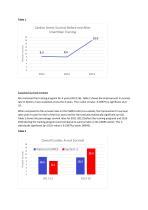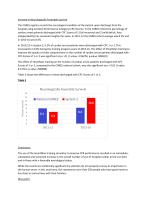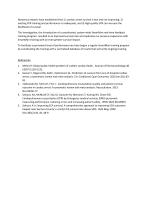 Website:
SmartMan
Website:
SmartMan
Group: V4EMS
Catalog excerpts

Real-Time Feedback during Cardiopulmonary Resuscitation (CPR) Training and Testing Improves Survival in Out-of-Hospital Sudden Cardiac Arrest Patients. Angelo Salvucci, MD, FACEP, FAEMS Medical Director Santa Barbara County Emergency Medical Services September 21, 2018 Abstract This a replication and extension of a previous study that aimed to increase cardiac arrest survival rates by utilizing the SmartMan manikin simulator to improve cardiopulmonary resuscitation (CPR) training across an entire system. CPR performance data was reviewed and overall survival and Cerebral Performance Category (CPC) scores were compared to the national Cardiac Arrest to Enhance Survival (CARES) cohort. After a focused CPR training program the percentage of cardiac arrest patients who survived to hospital discharge within the study area, compared to the prior twoyear benchmark, increased by 122% - from 8.1% to 18.0%. The increase in percentage of survivors for the duration of the training program, 2013-2016, when compared to the CARES cohort, was statistically significant (9.9% vs. 15.5%, p<.01). The increase in number of survivors with CPC scores of 1 or 2 (favorable neurological function) compared to the CARES cohort was also statistically significant (p<.01) (t-value 8.21761, p-value .000088). This study showed that the results achieved in the previous study could be replicated and improved upon. Training with the SmartMan manikin simulator with its visual color feedback system was successful in increasing the number of cardiac arrest survivors. Background: Cardiovascular disease is responsible for an estimated 30% of global mortality, and 50% of those deaths are Sudden Cardiac Death.1 Survival from out-of-hospital cardiac arrest is less than 1% globally and 5% in the United States and has not improved over the last 30 years.2 Human and animal studies have identified continuous high-quality chest compressions to be an essential component in successful resuscitation.3 In our previous work we found that: 1) chest compression performance by on-duty EMS personnel with traditional CPR training was poor but improved substantially after a brief training session with the SmartMan visual-feedback training manikin simulator4, and 2) a system-wide SmartMan CPR training project improved cardiac arrest survival.5 The studies were performed in a California, USA region with an overall population of 1.4 million. Regional Emergency Medical Services (EMS) treats approximately 600 cardiac arrests from presumed cardiac etiology annually. There are two independent systems within the region. System 2 EMS began measuring cardiac arrest survival rates upon joining the nation-wide Cardiac Arrest Registry to Enhance Survival (CARES) program in 2010. In the first two years after joining this program survival rates were at or below the CARES cohort average and substantially less than in System 1. This investigation in System 2 was designed to replicate the improved survival rates reported in System 1.
Open the catalog to page 1
Objective: The objective of this study was to determine if the introduction of an EMS system-wide CPR training program with the SmartMan visual feedback manikin simulator would result in a measureable improvement in cardiac arrest survival. Methods: This was a prospective evaluation of EMS system performance for patients in cardiac arrest. The intervention evaluated was CPR training with the SmartMan visual feedback manikin simulator. An EMS CARES Quality Improvement Committee was formed upon joining the CARES program. CPR performance data was reviewed and compared to the national CARES...
Open the catalog to page 2
Cardiac Arrest Survival Before and After SmartMan Training (O > > k_ 3 00 +-* c 18.0 2011 2012 2013 Sustained Survival Increase We continued the training program for 4 years (2013-16). Table 2 shows the improvement in survival rate in System 2 was sustained across the 4 years. The t-value (t-value -4.36975) is significant at p< .01. When compared to the survival rates on the CARES cohort as a whole, the improvement in survival rates year on year for each of the four years and for the total was statistically significant (p<.01). Table 2 shows the percentage survival rates for 2011-2012...
Open the catalog to page 3
Increase in Neurologically Favorable Survival The CARES registry records the neurological condition of the patient upon discharge from the hospital using Cerebral Performance Category (CPC) Scores. In the CARES cohort the percentage of cardiac arrest patients discharged with CPC Scores of 1 (full recovery) and 2 (mild deficit, lives independently) has remained roughly the same. In 2011-12 the CARES cohort average was 8.1% and in 2013-16 was 8.4%. In 2011/12 in System 2, 6.2% of cardiac arrest patients were discharged with CPC 1 or 2. This increased to 13.6% during the training program years...
Open the catalog to page 4
Numerous reports have established that: 1) cardiac arrest survival is low and not improving, 2) existing CPR training and performance is inadequate, and 3) high-quality CPR can increase the likelihood of survival. This investigation, the introduction of a coordinated, system-wide SmartMan real-time feedback training program, resulted in an improved survival rate and replicates our previous experience with SmartMan training with an even greater survival impact. To facilitate a permanent level of performance we have begun a regular SmartMan training program by coordinating the training with a...
Open the catalog to page 5All SmartMan catalogs and technical brochures
-
Smartman AM1
3 Pages
-
RS RSIM ARDS
3 Pages
-
BLS CPR Pro
1 Pages
-
BLS CPR Pro+
1 Pages
-
Baby Pro
1 Pages
Archived catalogs
-
Computer Caddy
1 Pages
-
Laptop
1 Pages
-
Wireless
1 Pages
-
Jaw Thrust
1 Pages
-
BLS Pro CPR Features Sheet
1 Pages
-
SmartMan Wheeled Duffle
1 Pages
-
SmartMan Arms and Legs
1 Pages
-
LOW VOLUME (LV)
1 Pages
-
Multi-Manikin Viewer
1 Pages
-
SmartMan General Brochure
2 Pages
-
BLSLV CPR Pro
1 Pages
-
BLSLV CPR Pro+
1 Pages
-
ALS CPR Features Sheet
1 Pages
-
ALS CPR
1 Pages
-
ALS CPR Pro
1 Pages
-
ALS CPR Pro+
1 Pages
-
Low Volume
1 Pages
-
Megacode Features Sheet
1 Pages
-
Megacode
1 Pages
-
Megacode Pro
1 Pages
-
Megacode Pro+
1 Pages
-
Baby Pro+
1 Pages
-
Neonate Pro
1 Pages
-
Neonate Pro+
1 Pages
-
IV Trainer
1 Pages
-
IO Kit
1 Pages








































